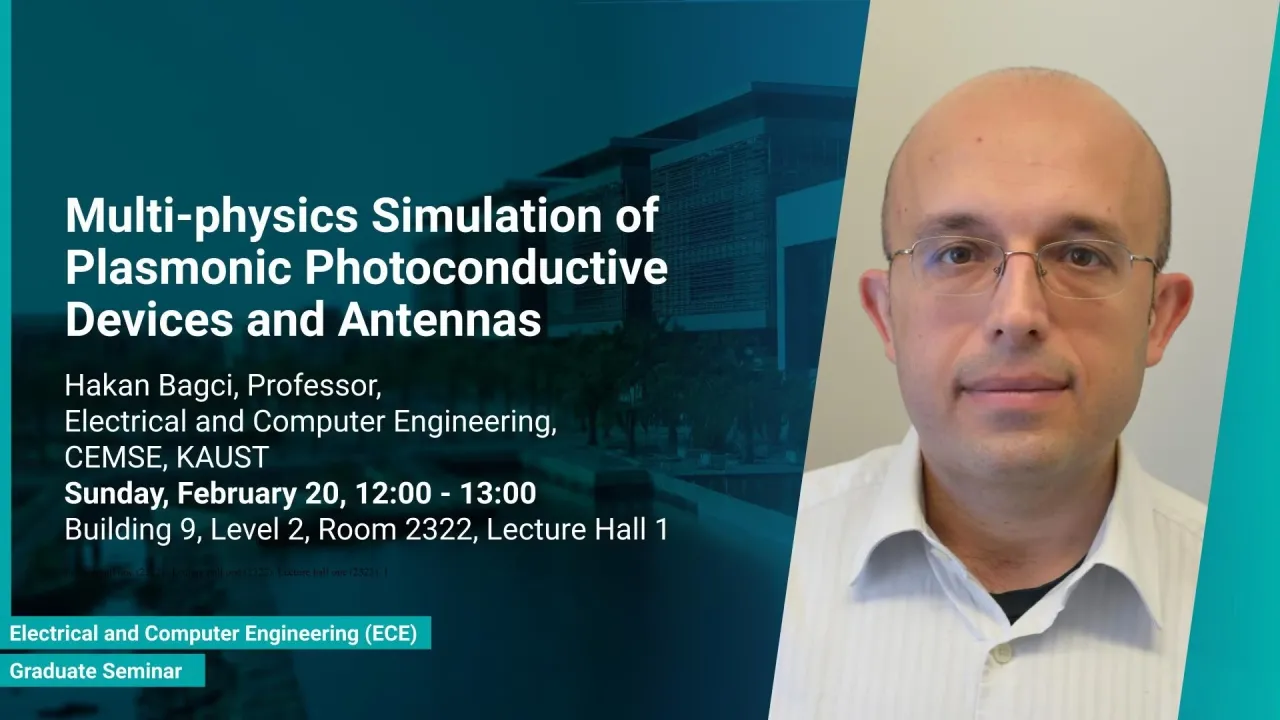
Multi-physics Simulation of Plasmonic Photoconductive Devices and Antennas
Terahertz (THz) frequency electromagnetic fields have numerous applications ranging from wireless communications to imaging systems and nondestructive testing, to material characterization. One of the main obstacles in the way of widespread industrial use of THz technologies is the difficulty of implementing compact and frequency-stable THz sources that can operate at room temperatures. Among a variety of possible options, photoconductive devices (PCDs) satisfy these conditions. Indeed, they have become one of the most promising candidates for THz source generation since recent advances in fabrication techniques, such as metasurface integration and nanostructured surface inclusions have significantly increased their optical-to-THz conversion efficiency and made them polarization insensitive.
Overview
Abstract
Terahertz (THz) frequency electromagnetic fields have numerous applications ranging from wireless communications to imaging systems and nondestructive testing, to material characterization. One of the main obstacles in the way of widespread industrial use of THz technologies is the difficulty of implementing compact and frequency-stable THz sources that can operate at room temperatures. Among a variety of possible options, photoconductive devices (PCDs) satisfy these conditions. Indeed, they have become one of the most promising candidates for THz source generation since recent advances in fabrication techniques, such as metasurface integration and nanostructured surface inclusions have significantly increased their optical-to-THz conversion efficiency and made them polarization insensitive.
While experimental research on plasmonic PCDs has made rather significant progress, there is still room for improvement in rigorous numerical modeling of electromagnetic/electronic interactions on this type of devices. In this presentation, I will talk about my research group’s recent efforts on developing simulation tools for PCDs. More specifically, I will provide the details of a framework we have developed for rigorously-coupled simulation of electromagnetic interactions and carrier dynamics. This framework uses the Maxwell and the drift-diffusion equations to describe the behavior of electromagnetic fields and charge carriers, respectively. The photocurrent induced by carriers’ movements is coupled with electromagnetic fields through the current term in Maxwell equations. Electromagnetic fields are coupled to carriers through the drift term and the charge generation in the drift-diffusion equations. To efficiently account for the multiple space and time characteristic scales involved in this multi-physics and multi-equation model, discontinuous Galerkin (DG) schemes are used for its discretization. At my talk, I will present real-life examples, which demonstrate the accuracy and the efficiency of this DG-based framework.
Brief Biography
Hakan Bagci received the B.S. degree in Electrical and Electronics Engineering from the Bilkent University, Ankara, Turkey, in June 2001; and the M.S. and Ph.D. degrees in Electrical and Computer Engineering from the University of Illinois at Urbana-Champaign (UIUC), Urbana, IL, USA, in August 2003 and January 2007, respectively. From January 2007 to August 2009, he was a Research Fellow with the Radiation Laboratory, University of Michigan, Ann Arbor, MI, USA. In August 2009, he joined KAUST, where he is currently a Professor of Electrical and Computer Engineering. His research interests include various aspects of theoretical and applied computational electromagnetics with emphasis on formulating and implementing accurate, stable, and efficient time-domain integral and differential equation solvers to simulate electrically large, multi-scale, and highly complex electromagnetic systems.
Dr. Bagci was the recipient of the 2004-2005 Interdisciplinary Graduate Fellowship from the Computational Science and Engineering Program, UIUC, Urbana, IL, USA. He received the International Union of Radio Scientists (URSI) Young Scientist Award presented at the XXIXth URSI General Assembly in August 2008. In the same year, he was one of the three finalists (with honorable mention) for the Richard B. Schulz Best Transactions Paper Award given by the IEEE Electromagnetic Compatibility Society. He authored (as student) or co-authored (as student and advisor) 18 finalist/honorable mention papers in the student paper competitions at the 2005, 2008, 2010, 2014-2018, and 2020 IEEE Antennas and Propagation Society (APS) International Symposiums and 2013, 2014, 2016-2019 Applied Computational Electromagnetics Society (ACES) Conferences. He was one of the recipients of the Gauss Center for Supercomputing (GSC) Award presented at the International Supercomputing Conference (ISC) High Performance in June 2020. In July 2021, he received the KAUST Distinguished Teaching Award.
Dr. Bagci is currently an Associate Editor for the IEEE Transactions on Antennas and Propagation, IEEE Journal on Multiscale and Multiphysics Computational Techniques, and IEEE Antennas and Propagation Magazine. He was the vice-chair of the technical program committee for the IEEE APS International Symposium that was held in Atlanta, GA, USA, in July 2019. Dr. Bagci is a senior member of the IEEE and the URSI Commission B. In January 2021, he was elevated to ACES Fellow.